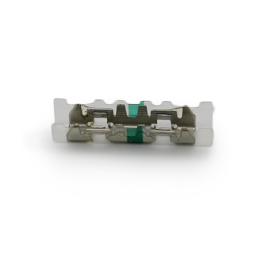Human society faces the contradiction between the scarcity of resources and the unlimited demand. Economics is a discipline that studies how to achieve optimal allocation of resources to maximize the satisfaction of human needs. The following is a discussion of smart grid planning and construction issues from the perspective of economics.
Smart Grid Cost-benefit Analysis
As a large-scale construction project based on investment by governments and power companies, the smart grid has large construction investment, long cycle, and wide social influence. This requires scientific demonstration, analysis of its expected input costs and benefits, and analysis of its investment value. In order to achieve scientific decision-making.
First of all, it analyzes the need to invest in the construction of a smart grid, which is to weigh the impact of investment and non-investment on costs and benefits. According to preliminary estimates by the United States EPRI, the US needs to invest 165 billion U.S. dollars in the next 20 years for the development of the smart grid, and the social benefits are 638 billion U.S. dollars to 802 billion U.S. dollars, and the smart grid investment rate of return is about 4, which is still a conservative estimate. At present, the generally accepted view at home and abroad is that investment is obviously stronger than non-investment. One of the original driving forces for the construction of smart grids is that if they do not invest in construction, their costs and costs will increase over time. The costs include: direct and indirect loss of power outages, low loss of electrical reliability, Loss of unqualified power quality, cost of grid obstruction, loss of large-scale access to renewable energy, etc. Abroad, a large number of analyses have been conducted on the issue of loss of blackouts, and there is still a lack of systematic analysis and research in this area.
Then analyze how to get the maximum benefit with the minimum cost, that is, the problem of evaluating different investment construction plans. Economic efficiency is the first evaluation indicator that people are concerned about and is relatively easy to calculate. Environmental and social benefits are more difficult to measure. However, the environmental and social benefits of smart grid implementation are considerable. For example, one of the goals of the smart grid implementation is to facilitate the access of distributed energy sources and realize energy, including large-scale and high-efficiency utilization of renewable energy. Distributed energy use has the advantages of environmental friendliness, low emissions, and zero emissions. Their contribution to environmental protection, energy conservation, and emission reduction can be reflected through the rational design of environmental benefits. This requires that in the development of smart grid planning, we must calculate the economic, environmental and social benefits, conduct a comprehensive cost-benefit analysis, and fully consider the good externalities brought by the smart grid, not just economic accounts. Only then can we be more motivated to formulate policies and regulations that encourage the development of smart grids and promote the development of smart grids.
Smart Grid Technology Innovation, Technology Transfer and Technical Capability Building
Whether it is from the perspective of the development of smart grids or from the perspective of building an innovative country, it is inseparable from technological innovation. The smart grid itself is a comprehensive embodiment of many new technologies and provides a very broad market application scenario for various new technologies.
The ways of technological innovation are divided into three types: original innovation, integrated innovation, and introduction, digestion and absorption. Original innovation is achieved through theoretical innovation, principle innovation, and method innovation. Integrated innovation is the integration of a number of independent elements and units through creative integration into an organic function; introduction, digestion and absorption, and innovation are introduced, digested, and Absorb innovations based on advanced technologies at home and abroad.
Technological innovation often begins with the introduction, digestion, absorption and re-innovation, and then it develops to integrated innovation and then to original innovation. The development of smart grids cannot be closed doors, and it is not possible to refuse foreign advanced technologies for independent research and development. In the initial stage, various forms of technology transfer should be adopted to extensively learn from foreign advanced technology and experience.
The international technology transfer model can be classified from different perspectives according to different classification criteria. One is whether the international technology transfer is market-mediated or not, and the technology transfer model is divided into market-mediated technology transfer mode and non-market media technology transfer mode.
If the common international technology transfer model is arranged in a decreasing manner depending on the degree of dependence on the market, it is followed by foreign direct investment (FDI), licenses, joint ventures, granted privileges, market contracts, technical service contracts, turnkey contracts, International subcontracting and non-traditional transfer channels, such as reverse engineering, reverse talent flow, etc. The other type is based on whether international technology transfer has transferred technology as a clear goal and is divided into formal technology transfer mode and informal technology transfer mode. If the common international technology transfer model is arranged according to whether or not the technology is a clear transfer target, such as FDI, licenses, joint ventures, granting market privileges, market contracts, technical service contracts, turnkey contracts, international subcontracting, etc. It is a formal technology transfer model, while reverse engineering, reverse talent flow, cooperative alliances, and other non-property rights are called informal technology transfer models.
In the past, in the process of international technology transfer, people preferred to use the market as the medium of formal technology transfer. Since technology is mainly composed of intentional knowledge, the difficulty of technology transfer lies in how to transfer the intentional knowledge. Learning to grasp strategic knowledge is the key to mastering technology. Instead of market media and informal technology transfer methods, not only transfer the technology itself. It also shifts the ability to reinvent technology, and as a result, the technology transfer models of both informal and non-market media have gained more and more attention in the current form of technological development.
It is very important to develop a smart grid and correctly handle the relationship between technology introduction and independent innovation. Neither can foreign advanced technology be rejected because of narrow protectionism, because it is harmful to the improvement of independent innovation capabilities, and the cost of domestic technology and products remains high, resulting in waste of resources and unfair distribution; nor can we blindly introduce foreign packages. Technology, in particular, cannot be introduced on a large scale in batches, so that the domestic market is completely occupied by foreign technology, blocking opportunities for domestic technological development. It is necessary to encourage cooperative R&D, encourage non-market media and informal technology transfer methods, focus on technological innovation capacity building, and improve the ability to reinvent imported technology on the basis of the introduction, digestion, and absorption. Span.
The combination of production, education and research of smart grid
The establishment of a smart grid cooperation system for production, learning and research is critical to the rapid development of smart grid technology.
The so-called industry, university, and research institute cooperation system is composed of six parts: government, production, education, research, intermediary, and finance. It is initiated by the industry, starting with research and development in the academic community and supported by governments, agencies, and financial institutions. After the successful market practice in the industry, an innovative system of cooperation and exchange between industry and education was formed.
The development of smart grid technology should be based on this three-dimensional cooperation network of production, teaching and research, led by enterprises in technology transformation and production and sales, colleges and research institutions to carry out technological innovation and personnel training, the government provides policy and legal support, intermediary organizations to communicate information , establish a cooperation network, and financial institutions are responsible for fund collection and operation. The six parties surround the integration of scientific and technological innovation, influence each other, promote each other, and form a dynamic chain of knowledge digestion, production, transfer, and value reengineering under the market mechanism. The close integration of research and industrialization has greatly shortened the cycle from knowledge to technology to products, and promoted the rapid application and development of smart grid technology.
Here, special emphasis is placed on the role played by universities and other scientific research institutions. Because the academic community represented by universities provides a source of new ideas, new methods, and new concepts, original innovations rely mainly on them. Close cooperation with universities can make up for the lack of innovation and R&D capabilities of companies.
Smart grid efficiency and power system reform
Smart grids will inevitably encounter problems with efficiency and institutional arrangements. The old institutionalism and neo-institutionalism in economics place the system in an important position in the economic and social life to examine the invisible hand of the market for the role of resource allocation, the proper role of government intervention in resource allocation, and the study of institutional changes. Rationality and rules follow the issue. In the market economy, people emphasize the ability of spontaneous or invisible hands to create and maintain socially beneficial institutions. The power market reform is an important institutional guarantee for ensuring the vitality and efficiency of smart grids. Whether the smart grid is operating efficiently is closely related to the establishment of a market-oriented system. Competitive market processes are usually more efficient. Under the condition of deregulation and promoting competition in the electricity market, the efficiency of smart grids is guaranteed.
The invisible hand of the market will also be inefficient. This needs to be regulated and adjusted through policies, regulations, organizations (such as power regulatory committees, etc.) or government intervention.
Smart Grid Evolution and Design
As a large and complex system, the smart grid is not one-time, nor is it fixed. With the development of society and demand, as well as the continuous emergence of innovation, the smart grid will continue to evolve and develop.
The use of the concept of "novelty" in economics to express the discovery of new possibilities for action is the result of human innovation. Since it is impossible to fully foresee the novel creation, the actor can not take the optimal behavior. The optimal solution or optimal performance of the smart grid cannot be fully foreseen and implemented. It is very likely that some of the anticipated new technologies have not been implemented, but the new technologies that are not expected have emerged quietly. Therefore, the process of smart grid construction can only be one. The process of continuous development and even trial and error is based on experience. It is more appropriate to use satisfaction as a quantitative indicator for investigation.
China's smart grid can be hierarchically implemented:
1) The first level is the intelligent UHV transmission network with the purpose of solving the problem of uneven distribution of energy resources and economic development, improving the transmission capacity of the grid, and realizing long-distance large-capacity transmission. At this level, it is necessary to strengthen unified coordination and unified planning so as to facilitate the formation of a unitary or joint power grid with unified dispatch and operation.
2) The second level is the intelligent high-voltage power grid with the purpose of improving safety and solving large-scale renewable energy access. At this level, the grid company also plans and promotes the implementation of the unified plan, which has the advantages of low implementation resistance, low transaction costs (negotiation costs), and ease of unified scheduling.
3) The third level is the intelligent distribution network with the purpose of improving the quality and reliability of power supply and solving distributed energy decentralized small-capacity and multiple-quantity access. At this level, it is possible to carry out more pilot projects for the construction of smart grids that embody diversity and diversity, including demonstrations of micro-grid technologies, attract more participation from social forces, introduce market-based mechanisms, and encourage orderly competition to emerge. The various new programs are gradually standardized and given promotional suggestions based on practical tests and scientific comparisons.
The ultimate goal of the smart grid is to achieve economical, efficient, reliable, and safe operation of the grid, to achieve energy, including large-scale and efficient use of renewable energy, and to maximize economic, environmental and social benefits. It involves various fields such as energy, information, economics, and law and will have mutual influence and influence on factors such as technology, economy, society, and the environment. From the perspective of cost-benefit analysis of smart grids, it is necessary to build smart grids.
To develop a smart grid, we must correctly handle the relationship between technology introduction and independent innovation. Based on the introduction of digestion and absorption, we will focus on technological innovation capacity building and improve the ability to reinvent the imported technology.
The establishment of a smart grid cooperation system for production, education, and research is critical to the development of smart grid technology. It can shorten the cycle from knowledge to technology to product, and promote the rapid application and development of smart grid technology.
The power market reform is an important institutional guarantee for ensuring the vitality and efficiency of smart grids.
As a large and complex system, the smart grid is not one-time, nor is it fixed. With the development of society and the improvement of demand, with the continuous emergence of innovation, the smart grid will continue to evolve and develop. Smart grids can be implemented according to different levels of demand stratification.
The wire connector is ideally suited for all types of cable splicing needs. Use simple tools and small splice bundle. Cable Connector have 3M types and Tyco Types to select. Also have tool-less gel filled connector and with tool punch down connectors.
Key Features:
– Designed and built around proven Insulation Displacement Connection (IDC) technology and manufactured using best practices, Wire Connectors can endure harsh climatic conditions.
– A single crimp displaces the insulation and provides a cold solder equivalent connection, delivering low contact resistance.
– cable connectors are available in different types and versions for all your splicing applications and solutions.
– The connector covers are color coded for easy identification.
– The new series with increased port hole size and double contact design, offers the advantage of full wire range.
This is a tool-less gel-filled connector, making it easier to use and resulting in less corrosion of the connection, which improves stability for the end customer. This results in increased broadband speeds and reduced line faults. The connectors do not have test access ports, however they can be easily opened and re-opened by hand for testing.
Key Features:
• Accommodates 22-26 gauge copper conductors in straight splice and half-tap configurations
• Pair-per-connector design produces smaller, neater splice bundles
• Available with a filled, moisture resistant compound that provides protection from the elements in the Outside Plant environment
• Unfilled version provides flame retardant protection for buildings and cable entrance applications
• Reliability of the connection can be verified visually or tested with test clips
• Minimum installation effort required




|
Plastic Cover (Mini Type) |
PC with blue coading (UL 94v-0) |
|
Plastic Cover (Green Type) |
PC with green coading (UL 94v-0) |
|
Base |
Tin-plated brass / bronze |
|
Wire Insertion Force |
45N typical |
|
Wire Pull Out Force |
40N typical |
|
Cable Size |
Φ0.4-0.6mm |
FAQ:
Q: Are you trading company or manufacturer ?
A: We are factory.
Q: How long is your delivery time?
A: Generally it is 3-5 days if the goods are in stock. or it is 15-20 days if the goods are not in stock, it is according to quantity.
Q: Do you provide samples ? is it free or extra ?
A: Yes, we could offer the sample for free charge but pay the cost of freight.
Q: What is your terms of payment ?
A: Payment<=5000USD, 100% in advance. Payment>=5000USD, 30% T/T in advance , balance before shipment.
If you have another question, pls feel free to contact us as below
Cable Connector
Cable Connector,Wire Connectors,Coaxial Cable Connectors,Coaxial Connector
DOWELL INDUSTRY GROUP LIMITED , http://www.dropwirechina.com